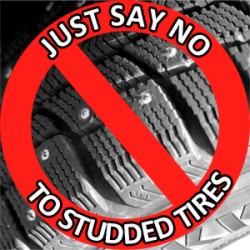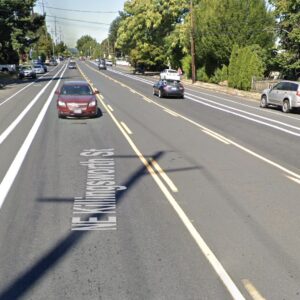
(Graphic: BanStuddedTires.com)
Today is November 1st, the first official day of studded tire season in Oregon. Back in March we shared why people who ride bikes should care that studded tires do $50-60 million in road damage each year and we also shared that one man was committed to putting a stop to it.
Portland citizen activist Jeff Bernards and a group of volunteers want to ban studded tires in Oregon through a ballot initiative that would be filed in 2012. I checked in with Bernards today to see how things are going.

(Photo © J. Maus)
As you can see on BanStuddedTires.com, the effort is still moving forward in earnest. In July, Bernards and volunteers completed a draft of the initiative language. At the end of September, Bernards made a trip to Salem to meet with the state’s Legislative Council (they write language for new laws) to make a few tweaks to the draft. With the onset of studded tire season, Bernards is also working on an op-ed he hopes to publish in The Oregonian this week.
High on Bernards’ list right now is to find someone to help him with strategic planning moving forward. He admits that putting an initiative on the ballot is a major task, but he’s committed to seeing this effort through.
“It’s almost bigger than me… It’s a huge project. Giving out lights was easier! But the more I learn the more I’m convinced what an important an issue this is, especially considering the budget crisis Oregon is facing.”
Besides the cost-savings the state would save by not having to repair roads as frequently, Bernards calls studded tires “outdated technology.” He points out that even ODOT has stopped using them on their fleet of service vehicles.
For Bernards, the issue is simple. Damage caused by studded tires is a waste of money. “I’m doing this because we need teachers not studded tires… This is the opportunity to show the taxpayers that there’s no free choice in choosing to use studded tires that cost all of us.”
Learn more at BanStuddedTires.com.






Thanks for reading.
BikePortland has served this community with independent community journalism since 2005. We rely on subscriptions from readers like you to survive. Your financial support is vital in keeping this valuable resource alive and well.
Please subscribe today to strengthen and expand our work.
You can fool the general public by their ignorant perception that since studded tires sound damaging, they must be the cause of ruts. Go ahead, take an aluminum can and drag it on asphalt to see which damages which. Aluminum is a soft metal and dulls in short order.
Loaded up 100 psi truck tires is what causes damage. Most non-truckers don’t realize that those tires must run at great pressures to be able to take the heavy loads that they do. This increases the pressure per square inch on asphalt by a huge magnitude compared to passenger car tires, causing micro fractures on the road surface.
tire studs are not aluminum, they are carbide steel, and they erode the soft matrix (either cement, which is basically soft calcium carbonate, or long chain tarry hydrocarbons) from between the harder aggregate in the road bed, eventually loosening the aggregate and leading to the formation of ruts.
Overweight trucks cause deeper roadbed damage, but the surface ruts you see are characteristic of studded tire damage.
mello, care to offer any facts to back up your opinions?
I find it kinda comical that cyclists are anti studded tires on cars… but when the ice comes we’re all about them for our bikes. Granted the differences- and potential for damage/costs to public property- are huge (apples to oranges), but it’s still pretty funny in concept.
Really great to see Jeff working on this effort- he’s the kind of guy who gets stuff done and I’m behind him all the way on this one!
What is the cost if the state starts to use salt or other chemicals on the roads to allow cars not to require studs and/or chains ?
Neighbor,
I think the % of cyclists who actually use studded tires on their bikes is probably in the single digits, if even more than 1%.
“we’re all about them” is a pretty broad generalization.
Neighbor (and Tony!)
I’m one of the 1% or less that actually owns studded bike tires. They came in handy during Snowpocalypse ’08. They suck for riding any other time. I doubt there are bicyclists who use studded tires full-time from Nov-April like some people in cars would.
@5, Oregon uses gravel but does not use salt. With a few exceptions we simply don’t have the kind of ice etc that would even be helped by studs, and these days studless snow tires are so good that there just is no need for studded tires in our state, which is why they should be banned.
And for cyclists and pedestrians…the larger issue is traffic safety 99.9% of the year when the lane lines, crosswalks, and stop bars are degraded much quicker due to the over dependence on studded tires in most urban areas (SW Washington too).
My biggest concern with studded tires is how poorly they handle in wet conditions. With the majority of the Oregon population living and driving daily in the WET western half, they are a hazard.
Even going to timberline, at least half the drive is going to be on wet, but not snow covered or icy roads. Modern snow tires are as good snow, much better in the cold -wet than any other tire and nearly as good on ice.
mello–
There are two types of road damage that result in ruts: displacement, which is the squishing of soft paving materials up and out of the main tire tracks of a roadway, and ravelling, which is the actual removal of paving material from the roadway surface. Both of these types of rutting are possible on asphalt, but only ravelling will cause ruts on concrete road surfaces (concrete is hard and cannot be displaced). Most studies of studded tire damage are done on concrete road surfaces, since the combined causes of ruts on asphalt make it hard to determine how much damage is done by each type. On these concrete surfaces, the amount of damage that can be attributed to studded tires is significant. If material can be removed from concrete, which is hard, then it is reasonable to assume that it can also be removed from asphalt, which is softer, leading to the conclusion that displacement and ravelling both contribute to rutting on asphalt surfaces. Now, it might be the case that if tiny asphalt chunks are peeled up from the roadway and then deposited back onto the surface, they might re-meld with the asphalt surface and the loss might be marginally less than on concrete road surfaces, but it is more likely that any tiny chunks peeled up during cold weather will be blown or washed away before any such re-melding could take place. $50-60M is not a far-fetched number.
Charge an installation fee per studded tire, to go directly to funding road repair. It could be structured like the gas tax, with local, state, and federal components. Start it out at $10/tire.
Why ban them? Just tax the sale and installation of studded tires. There are a handful of people who need and really want them.
@ #12. I would venture a guess that each studded tire causes a heck of a lot more than $10 worth of damage over it’s lifetime. I’d start the fee at something more like $100 per tire.
Instead of banning studded tires, why not tax them to pay for the road damage they cause? If studded tire users have to pay for their choice, they’ll certainly understand that the benefits of being able to drive in the 2/3 day of snow we get each year will outweigh the costs.
Even a tax of $50/tire (which wouldn’t come close to repaying the $50M damage listed in this article) would give the casual users pause before tearing up the roads. Carve out exemptions for those who live or work in remote/mountainous sections of Oregon and we’ll solve a lot of the problem.
I took a walk downtown today and heard a lot of cars driving around with studs on… it’s ridiculous that they are already in use just because we’ve passed an arbitrary calendar date.
What about police and ambulances? fire trucks, how about those PGE trucks that have to come out to your house in the snow storm to restore power to your house? How about that pizza delivery guy working for minimum wage and is working so he dosen’t get fired (and so you can eat and not go out) what about the doctors and nurses that has to get to the hospital to fix the hip you broke riding your bike on ice? …….
@Jim #16:
Oh what the hell, I’ll contributed to the hyperbole.
Consider: studs actually hinder traction in most winter driving conditions we have in oregon. Ever slammed on the breaks and tried to stop quickly with studs on in dry, wet, or slushy-snow conditions? They are a liability for stopping, and cornering, in anything but solid ice.
Also, ruts on the roadway, made worse by studded tires, collect funnel all the water directly to the tire…exactly where you don’t want water to be.
The stopping distance on dry or wet pavement is only very minimally longer. The advantages on ice are massive.
Just a thought why not read up on what the Scandinavians have done with studs. The studs they use cause way less damage then the US studs. Ranging for 60-90% less depending on studs. (http://www.wsdot.wa.gov/research/reports/fullreports/471.1.pdf Look around page 9)
rutted roads make it much more likely for cars to hydroplane in wet weather conditions, and contribute to excessive road spray; that’s unsafe for everyone on the road.
BURR:
Call Les Schwab or whatever tire retailer and ask. They’ll tell you they’re aluminum, whether or not they’re lying is anyone’s guess. They switched years ago.
My “opinions” come from road engineers.
FWIW, I hate studded tires and would support a ban, but only because they’re annoying to hear.
Les Schwab’s web site offers no info on the composition of studs.
Here’s some studded tire facts from the ODOT web site:
Studded tire facts
You can use studded tires in Oregon from Nov. 1 through March 31. Driving with studded tires before Nov. 1 or after March 31 is a Class C violation and carries a $190 fine.
Research shows that studded tires are more effective than all-weather tires on icy roads, but are less effective in most other conditions because they may reduce traction between the road and the tire.
Oregon spends more than $11 million a year fixing roads and bridges damaged by studded tires.
When it rains, water collects in the pavement ruts caused by studded tires and creates dangerous driving conditions. In cold weather, that water can freeze and cause extra-slippery roads.
http://www.oregon.gov/ODOT/COMM/winterdriving.shtml
growing up in new england there were no ruts on the road, there were also no studded tires to speak of on the east coast. I was so confused when I moved out here (“what is that weird sound coming from the cars”). This is not proof that studded tires cause road damage, just an observation. However, Oregonians can’t drive in the best of times so add snow or ice and disaster is a given…
From http://www.tripcheck.com/Pages/RCMap.asp?mainNav=RoadConditions&staticNav=ChainLaws:
Note: Although exempt, ODOT vehicles use mud and snow tires and chains in most winter situations. Studded tires are not used on ODOT vehicles because of the damage such tires cause to the highway.
Former ODOT bike guy Michael Ronkin pointed out to me that the state of Oregon spends roughly the same amount per year repairing damage from studded tires that they do on bike and pedestrian facilities…kind of puts it in perpective.
The facts are overwhelmingly clear that studded tires DO in fact cause significant road damage. http://banstuddedtires.com/facts
We won’t need to use more chemicals to offset studded tire use, in fact you could argue that studded tire damage releases more toxic dust into our water supply and natural reserves. Newer studless tires are quite capable.
ODOT’s analysis of long-term costs does not account for city or county roads, so the numbers are largely under reported. http://banstuddedtires.com/p/odot-has-no-clear-estimate-of-studded-tire-damage
jered @ 21.
“Oregonians can’t drive in the best of times so…”
please keep in mind that there are precious few native northwesterners here in town. to say oregonians/portlanders can’t drive is more accurately saying that everyone who moved here, predominantly from california, the upper midwest and the east coast can’t drive for shit.
BURR:
Is there any iron content in studs? I’m walking around the parking lot of work and so far my magnet didn’t work on 3 different cars with studded tires.
I found a statistic that says it takes a million car passes with studded tires over a road surface to cause .1 inch of abrasion. Is there really that many passes on a single road?
Of course a magnet won’t work, mello. The studs are made out of a tungsten carbide tip that protrudes out of a metal jacket inside the tire. Tungsten carbide isn’t magnetic but its compressive strength is higher than virtually all melted and cast or forged metals and alloys. No wonder it does all that damage to the roads.
Then how do you explain an old rusty studded tire in my backyard that is magnetic?
so what? all of those metals are harder than the asphalt or cement roadway matrix, even aluminum can be alloyed and hardened.
these are purpose-specific studs we’re talking about, spinning with the weight of a several ton car or truck behind them, that’s not the same as rubbing a beer can on the pavement, who do you think you’re fooling?
:rolleyes:
Then why do my coworker’s modern studded tires never last more than one season compared to the ones he used 10 years ago, which lasted several years. Maybe the local tire dealers changed to aluminum to minimize road damage. I called Les Schwab this afternoon and the nice lady told me they use aluminum studs. She must be a liar. It seems to me that the lives saved by studs is not worth the 11 million in costs to fix “damage.” I think this road rut issue is just an excuse because people hate the sound of studded tires on pavement.
On hardness…I happen to have access to a glazier’s shop with several pieces of scrap glass from customer orders. A pebble from a slingshot shattered a pane of glass but an aluminum(I presume) stud I plucked out from a coworker’s tire did not. I pulled the slingshot an equal length on both shots. From that unscientific test, I concluded that the pebble was harder. I plucked the pebble from the parking lot, which I presume is asphalt.
@barney, oregon has laws against salt and only use deicer when they know it’ll so because the deicer is only effective below the snow, not on it. When they do get icer down they only do the bridges and steep hills. And we are in portland where the worst winters bring maybe a week of snow. Nothing a few tire chains and walking can’t combat.
mello yellow and BURR:
Metal stud composition: the contact point of the studs is carbide across all makes of studded tires, both auto and bike. The big difference has been in the stud shell which can be easily made from any ole steel but when low weight or anti-corrosive properties are needed. Neither have any chemical properties that keeps them from popping/ripping out when you nail the brakes on pavement.
As one of that vocal minority of cyclists with studded bicycle tires I can say I’ve ridden on them in this area less than 5 times and they were only truly useful during the ice storm back in 2004.
In areas where salt is applied, slush is constantly refrozen in to railroad ruts that travel parallel to that path of travel. It will often save your life to be able to ride over these frozen slush ruts that you normally toss you like the street car tracks.
All that being said: they are a waste of money on bicycles for all but the most determined cyclist. I have damaged epoxy coatings that go on concrete floors, both braking and simply riding. At a mere 175 lbs of bike and rider it is quite easy to leave large scrapes on concrete, asphalt, cobble stones, brick and even granite.
Studded bicycle tires are not needed in the Willamette Valley for the same reasons as that they are not needed on autos.
No wonder we can’t ride trails in Forest Park.
Material Hardness on Knoop Hardness scale
see chart at bottom of subheading Material Hardness & Abrasiveness.
Shows tungsten carbide as having a hardness of 2000, aluminum at around 120 (ref) and steel alloys can easily range from tungsten carbide down to some of the junkiest soft cold rolled steel.
All I know, is that no one uses studded tires in places with waaaaay more snow and ice than we get. What the hell do we need them for?
What’s sad is that because studded tires are so heavily subsidized, most people don’t have a clue of their true cost and they throw them on their car every year simply because that is what they have always done.
What’s sad is that because drivers are so heavily subsidized, most people don’t have a clue of their true cost and they drive around aimlessly every year simply because that is what they have always done.
Okay then, why, on a freshly paved section of 99w south of Sherwood, is there already tire “ruts” forming when studded tire season just started today?
I hate the sound of studded tires on bare pavement, but if we use junk science to justify our means like the Forest Park conservancy says bike tires cause erosion and trail degradation, we’re just as bad as them. Or just as keen politically.
#37
Hey look, wood’s got a hardness scale of 10. What a softy. Must be a real disappointment.
Mello,
I have yet to see ruts like the ones in Oregon in other states that do not have studded tires. I’ve lived near highways with greater truck traffic than I-5 in Oregon.
The ruts are far worse here.
After over a decade of living in the Gorge and driving on both studded and non-studded winter tires, I’ll take modern non-studded tires hands down. The studded tires were far worse in the rain (as mentioned above), and in addition to noise the studs would come out and beat the crap out of my car (even when they were new!). I felt far less control with the studded tires, and the one time I lost control was <25 MPH in a flat section just east of Cascade Locks.
My theory is people maybe have a (mis)perception of the effectiveness of studs by subconsciously relating it to the image of an ice climber using metal picks for grip. The reality is that the benefits of studs come into play at only the lowest of speeds in the iciest of conditions. I have no references to back that up, only decades of LOTS of winter driving in snowy mountainous places.
But yeah, you can get metal-studded tires cheaper than a set of, say, Blizzaks, so I can see this going over like a politician trying to raise a gas tax. Good luck Jeff.
I am guessing the modern lightweight studs are probably not as efective as the older style studs. Some of the newer studless snow tires are quite good.
Perhaps charging a permit to use studs could help offset repairs.
This is one of those decisions that really needs to be made by the people that know what they are talking about. There have been indepth studies made in regards to studded tires. perhaps there are some compromises that could be made
Re: Taxing installation of tires: that only works if everyone with studded tires takes their tires and cars to a tire shop to have that done. There are some of us who actually rotate our own tires, can change our own flat tires, and who swap our summer tires for winter tires in our own garages and driveways.
Studded tires are dangerous here in the Willamette Valley for usual driving around. Unless you live at higher elevations where snow is not a “maybe”, or you are going up to the mountain every single weekend or every single day, you don’t need studded tires.
People who arbitrarily put studded tires on November 1 just to drive around town are morons. That’s my opinion, but may verge on fact.
I’ll take good non-studded snow tires any day of the week.
But then again, I actually know how to drive when the weather gets nasty. Most people driving in the Willamette Valley do not– or at least, most people around Portland and the ‘burbs do not know how to drive in slippery conditions.
Re: the ruts in the 99W around Sherwood: as has been previously discussed (see #11), if the repaving was done with asphalt, the ruts may form because of all the large trucks driving from I-5/I-205 to Newberg, McMinnville, and points west accessible only by hwy 99W– compression of the road materials squishes asphalt out of the way resulting in ruts.
Mello– how long have those ol tires been sitting in your back yard?
Direct Quote from TireRack.com. (a company whose share price depends on selling studded snow tires)
“…reduce damage from the constant chipping of the surface of concrete and asphalt roads. Studded tires cause millions of dollars in road damage annually, as well as can increase the risk of hydroplaning in wet conditions due to the resulting ruts”
Further..
“Studs help slick ice traction, but can give up braking traction on dry and wet roads”
For the 2 days a year it snows in portland take transit or put on snow chains. If you can afford to go to the mountain every weekend, you can afford to have a dedicated mountain rig.
mello yello: The reason the pebble broke the window and not the stud is most likely due to the mass of each.
Studs are carbide cores jacketed by aluminum, steel or some alloy. It’s cheaper to clad a carbide core in another material rather than make the whole thing out of carbide, much like a diamond tipped drillbit – you only need the tiny pieces to make it effective.
To all who have used stud-less snow tires, please visit our site Banstuddedtires.com and post a comment. I need testimonials from people who have actually used Stud-less snow tires. I rode up Timberline road, covered with snow, with someone who had said snow tires, he was speeding up and never slid once. Please become a friend of Banstuddedtires on Facebook. We also have some information, regarding Oregon Legislators that were going to post very soon on our site, that should really add fuel to the debate about why nothing is getting done in Salem about this issue.
Studded tires on bikes: It probably is 1%, and I’m in that 1%. Maybe Q’tzal stays in Portland proper, but I find studs greatly improve the safety of my descent into Beaverton on frosty winter mornings. So here’s a deal: if you doesn’t like studded bike tires I won’t push for laws mandating that you use them, and meanwhile keep your laws off MY bike tires.
Bike studs have another awesome benefit: they punch through wet leaves, giving you confident cornering on the leafiest fall street!
Studded tires on cars: yes, tens of thousands of multi-ton vehicles driving around on studs wear down the pavement. Can’t believe anyone is arguing about this and conducting irrelevant experiments.
Studded tires do not suck in the rain, however. I’ve heard that BS myth for years, mostly from anti-stud partisans. I personally drove on studded tires for many years, and they gripped just as well on wet (and dry) pavement as non-studded snow tires. The studs themselves don’t significantly affect traction on pavement; any grip issues on pavement are going to be due to tread pattern and compound, as with any other tire. There are studless snow tires that suck in the rain too, you know (including, reportedly, the popular Toyo Observes sold at Les Schwab).
Studless tires: I’ve had several models of these. They are phenomenally better on ice than ordinary “all season” tires, and for those of us who hit the mountains on the weekends they do fantastically well. I’m always appalled at all the idiots (including, apparently, most Portlanders) who insist they need AWD for the winter, but then refuse to invest in seasonal rubber that will actually grip the road.
Still, the idea that the studless tires are AS GOOD as studs on glare ice is a myth. If you live in the mountains and have to commute on ice daily, you might still want to consider studs. Rather than seeing them banned, I’d rather see the state levy an excise tax on their sale.
On hardness…I happen to have access to a glazier’s shop with several pieces of scrap glass from customer orders. A pebble from a slingshot shattered a pane of glass but an aluminum(I presume) stud I plucked out from a coworker’s tire did not. I pulled the slingshot an equal length on both shots. From that unscientific test, I concluded that the pebble was harder. I plucked the pebble from the parking lot, which I presume is asphalt.
Your experimental method stinks. Pebbles are part of the roadway aggregate, not the matrix. You need to test the hardness against the pavement matrix, which is either cement (calcium carbonate) or asphalt. And do it while rotating the stud on a 440 rpm wheel (~30 mph) with 1,000 pounds of pressure (wt. of 4,000# car or truck applied by each wheel)behind it.